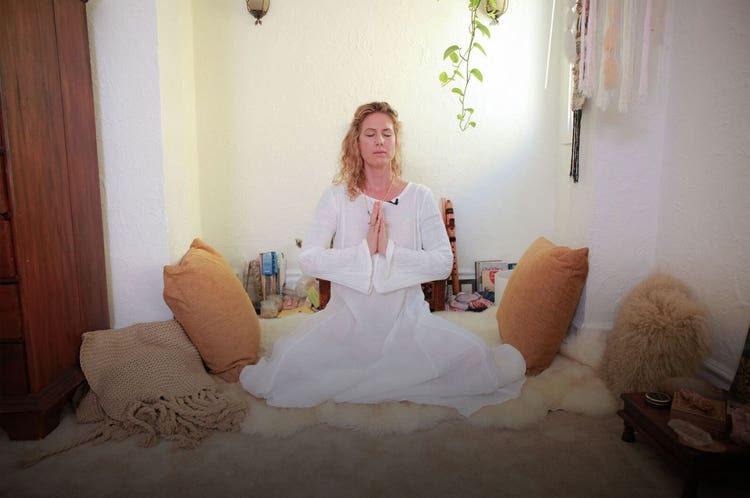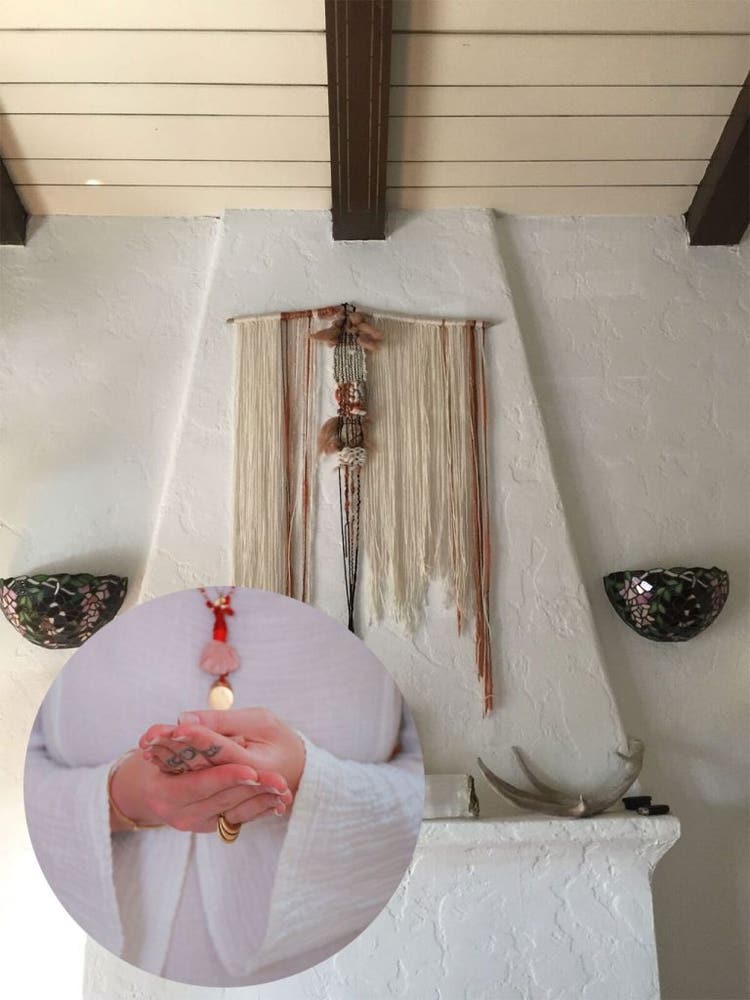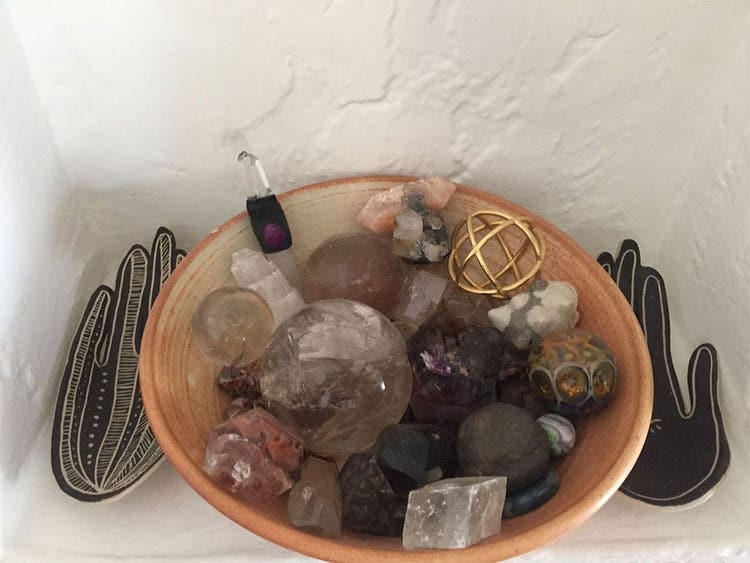Sacred Spaces with Taylor EyeWalker

Taylor EyeWalker designs a mindful life through ritual.
Kundalini yoga instructor. Spiritual counselor. Botanical alchemist. Those are just a few of Taylor EyeWalker’s trades — and she brings new meaning to the multi-hyphenate lifestyle.
“I wanted to create a life for myself that was completely out of my own inspiration, and I didn’t want to have to show up for anything or anyone that I wasn’t absolutely inspired to,” she explains.
24Life visited EyeWalker to ask her about the fundamentals of her daily life.
Tea for two — or one
EyeWalker lives in one of Southern California’s urban centers, but she has created a tranquil oasis in which each room reflects careful consideration of color, light, texture and sound — from the placement of furniture in the space, to the artful arrangement of objects in ways that simply elicit appreciation or that require pause, as before an altar.
A tea ceremony is a crucial part of her day. “In my home I always serve tea to my partner, and it’s one of the ways we create space together in the mornings,” EyeWalker says. Typically, she’ll wake up and do her meditations first and then serve him in a tea ceremony.
But it’s not simply about drinking tea. For EyeWalker, it’s about the ritual. “When I think about doing something out of a ritual or a ceremonial aspect, I have to first make sure am I going to get the most energy out of whatever I’m choosing to do right now,” she explains. “Every 24 hours without fail, I’ll do a meditation practice, the same one. As day 800 now approaches, it could be really easy for me to just feel like, ‘I’m not going to do my practice again.’”
She continues, “So I have to come to the table remembering why I’m continuing to do the same thing every day that looks like a ritualistic practice where I tune in, I meditate, I tune out. It could lose its potency and energy, and I’ve heard so many yogis and students of mine talk about how they lost their luster. The thing that they do every day has lost its potency. So ritual is essential. Setting up sacred spaces is essential.”
To make sure that ritual does not simply become an empty routine, EyeWalker asks herself why she is doing a ritual in the first place, and what the intention is. “It all starts with this basic, fundamental idea of being clear. Are we clear in our every movement, in our every moment in the day?”

EyeWalker observes that the tasks involved in the tea ceremony are more or less dependent upon the quality of the tea or expression you want to get from the tea (she uses “living” leaves from trees that have been carefully cultivated and tended in Yunnan in China as well as Taiwan) and the service. First and foremost, she says, is a clear heart and mind within the person performing the ritual, which makes a sacred space for the tea plant as well as the people who participate.
The ritual of movement
EyeWalker practices Kundalini yoga, which is considered a physically, mentally and spiritually rigorous discipline. Practitioners use breath control, physical exercises, visualization and chanting.
From EyeWalker’s perspective, movement — whatever the format — is never just about exercise or breaking a sweat: working that mind-body connection is key. “Every 24 hours, we are to do something to move our energy,” EyeWalker says. “Whether it be yoga, meditation, a strenuous or light workout, walking, jumping, shaking things up, that’s actually how we can continue to maintain this state of balance and equanimity in our body.”
EyeWalker emphasizes how movement releases more than physical energy. “If I’m ever getting stuck emotionally, the first thing I go to is physical movement. Maybe I’ll do strong breath practice or a rigorous physical workout to help move the blocked energy in my body, and that helps a lot. That’s why it’s really, really important that people take time to recognize how necessary it is to move.”
Emotional space
Even a basic conversation is a mindful one when you’re chatting with EyeWalker. “When I’m communicating with anyone, I want to make sure that I can first see and sense the clarity of what it is that I’d like to communicate and then make sure that the receiver is available for the type of communication that I would like to make to them,” she explains. “Ultimately, I’m looking for an end goal. I’m looking to be received and to receive what it is the other person has to share with me.”
As a teacher, that’s her first step in being able to sense what’s happening in an interaction. She’ll ask herself if there’s a more clear and concise way to deliver her message. “You want to stop the body, eyes, mind and the receiver and make sure they’re available, so eye contact is very important.”
EyeWalker adds, “Even physical contact — placing your hand on someone’s shoulder or grabbing their hand for a moment — is how we start to create deeper and juicier relationships with people. We use our communication so casually and generally, so poorly. This is a good way to make sure that I, myself, am doing my due diligence [all the time] to create more clear language on the planet.”
Space also becomes important in her interactions. Next time you feel yourself getting worked up, try EyeWalker’s technique. “If I feel emotional inside of my body and I’m in front of somebody, I’ve been taught how to create space inside of myself in a moment,” she says. “If I do not feel capable, I let the person know I need to go take care of myself right now. I have even said, ‘I’m actually feeling emotional at the moment, and I would just like to go and practice and take some space for myself so I can come to this situation feeling more clear.’”
Accepting that moment “where we don’t have the capacity to do anything other than be alone and close our eyes and just breathe and feel ourselves,” EyeWalker explains, is what we have to do “before we can come into any situation with anybody or anything.” She’s speaking of difficult conversations — as well as parking tickets.
“If we make sure we that we have enough energy before we get into a situation, and just look at the [parking restriction] signs, we don’t have to get into emotional states.”

Group effort
EyeWalker is a firm believer that there’s strength in numbers; it’s all about people working as a team. “Group consciousness is essential because then people can understand how to move to universal consciousness, because most people are in individual consciousness right now,” she says. “We’re living inside of our bubbles, and until we have our group, our family, those that we connect with, those that challenge us, those that help us see our biggest, deepest, darkest demons as well, then we can grow and rise above those aspects of ourselves.”
EyeWalker feels that when people share the same vision, then they can actually make something happen. “If we can learn how to be on the same trajectory as a group, we can start to make massive global change in whatever aspect our vision may be. It could be in technology, consciousness or bringing healthier food to people. It could be anything. But as long as we’re in the same vision, we can start to rise.”
Part of the importance of that collective vision stems from the fact that our notion of community is expanding. “Even though we have had the ability to drive our car or fly an airplane somewhere, the internet is providing such an incredible resource to connect with people that we may never have crossed paths with,” EyeWalker says.
“We want to make sure that we don’t make the internet or social media a replacement for the genuine connection that we have eye to eye, face to face, heart to heart with a human being,” EyeWalker explains. “But we do want to use it to energize our goals. That’s how I see social media and the internet and all of these modernized technologies, as a way to really build this global community. That’s my intention.”